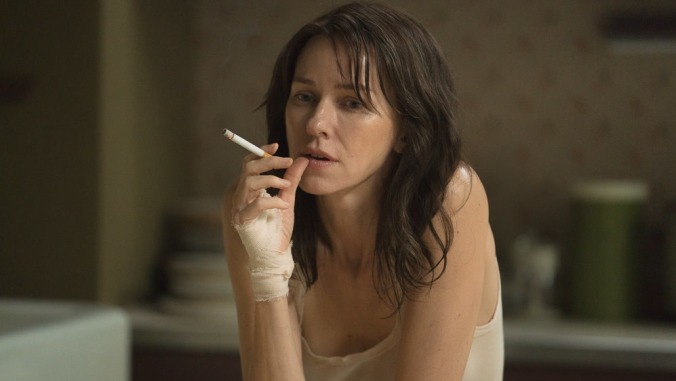Naomi Watts comes unglued in the claustrophobic but thin psychological thriller The Wolf Hour

New York City in the summer of 1977 must have felt like the end of the Roman Empire. Sweltering heat waves turned daily life into a sticky struggle, while rising inequality and poverty levels stoked social unrest, crime, and violence. At large was the Son Of Sam, a serial killer who stalked around with a revolver in search of brown-haired female victims, and one steamy July day, a city-wide power outage plunged the island into complete darkness. The smell of apocalypse was in the air. It’s in this rare moment in American history that writer-director Alistair Banks Griffin sets his sophomore feature, The Wolf Hour, a gloomy psychological thriller interested in the distinct paranoia of a woman living in self-exile in the South Bronx.
The movie, which premiered at Sundance in January, takes place almost entirely in a derelict apartment. It’s unclear just how long June Leigh (Naomi Watts), whose now-deceased grandmother owned the place, has been squatting there, though from the state of things—flies and empty bottles galore, bags of rotting trash—one could guess it’s been a while. June, it becomes readily apparent, is unwell. Disheveled and rail thin, she spends most of her listless waking hours smoking cigarettes and staring out the window. She refuses to leave the dingy apartment, nervously slipping her dwindling cash under the front door whenever the landlord comes looking for rent. The reasons for June’s self-imposed isolation remain ambiguous; though the apartment, shot to accentuate a decaying green hue, comes to resemble June’s deteriorating inner state, the film makes a strong suggestion that this shabby haven is preferable to the world that lies beyond its walls. The menacing pulse of the city, with its guns and murderers, encourages June’s reclusive behavior.
From her perspective, the most distressing external threat is an unidentified culprit who buzzes her apartment several times of day and through the night. There’s always silence on the other end, which makes answering the door for any potential visitor a particular source of dread. The plot is sparse and uneventful, a turn-off for anyone expecting jumps and thrills. But Watts, who plays her jittery paranoiac with the raw, tormented energy of a drug addict, convincingly sets the mood, so that even the slightest intrusion is cause for panic. June eyes wry bodega delivery boy Freddie (Kelvin Harrison, Jr.) with suspicion. And when Margot (Jennifer Ehle), an old friend and fellow creative, offers to help her out of her rut, she lashes out disproportionately.
As the story unfolds, it’s revealed that June is a writer of moderate acclaim struggling to finish the follow-up to her provocative first novel, The Patriarch. Has her behavior following its success alienated her from her family and sabotaged her romantic relationships? Griffin peppers these hints throughout in frustratingly small doses; they register as checklist components of a mental breakdown rather than meaningful aspects of June’s psychology. Meanwhile, the film tries to emphasize the horror of leaving a safe space, but the effect of seeing Watts freeze and topple to the floor as she attempts to go down a flight of stairs is unsubtle and unintentionally funny.
Eventually the need for money and the touch of another warm body galvanizes June into action, and even as neighborhood crime goes from bad to worse, she begins to see the light at the end of the tunnel. Unfortunately the work of putting together the puzzle pieces of her derangement has little payoff. Griffin is committed to expressing June’s inner state through her claustrophobic experience, but shies away from explaining why she’s afraid she’ll “fuck everything up” if she goes outside. As June observes her neighborhood, filled primarily with people of color, The Wolf Hour begins to feel strangely like an allegory for the paranoid fears of white women in a world of scary Black men. It’s a natural side effect for a film that so emphatically portrays a menacing exterior while only superficially exploring its protagonist’s interior.